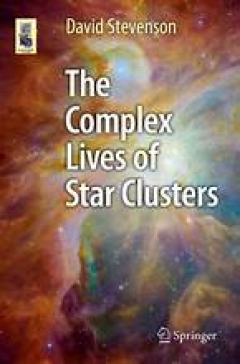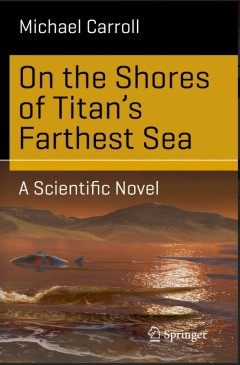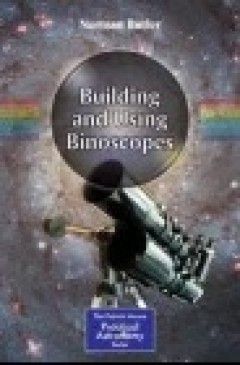Filter by

The Earliest Stages of Massive Clustered Star Formation: Fragmentation of Inf…
This thesis presents an in-depth, high-resolution observational study on the very beginning of the formation process: the fragmentation of dense molecular clouds known as infrared dark clouds (IRDCs). Using the Submillimeter Array (SMA) and Very Large Array (VLA) radio interferometers, the author has discovered a common picture of hierarchical fragmentation that challenges some of the leading t…
- Edition
- 1
- ISBN/ISSN
- 978-3-662-44969-1
- Collation
- XX, 145, 14 b/w illustrations, 23 illustrations in colour
- Series Title
- Springer Theses
- Call Number
- -

The Complex Lives of Star Clusters
As with the author’s recent books Extreme Explosions and Under a Crimson Sun, the complex topic of star clusters is broken down and made accessible with clear links to other areas of astronomy in a language which the non-specialist can easily read and enjoy. The full range of topics are addressed regarding how star clusters are formed. Why is it some are dense conglomerates of stars while oth…
- Edition
- 1
- ISBN/ISSN
- 978-3-319-14234-0
- Collation
- XV, 343, 64 illustrations in colour
- Series Title
- Astronomers' Universe
- Call Number
- -

A Breviary of Seismic Tomography: Imaging the Interior of the Earth and Sun
This is the first textbook to cover the essential aspects of the topic at a level accessible to students. While focusing on applications in solid earth geophysics, the book also includes excursions into helioseismology, thereby highlighting the strong affinity between the two fields. The book provides a comprehensive introduction to seismic tomography, including the basic theory of wave propaga…
- Edition
- -
- ISBN/ISSN
- 9780511984709
- Collation
- -
- Series Title
- -
- Call Number
- -

3K: The Cosmic Microwave Background Radiation
What processes fixed the designs etched on the cosmic background radiation (CBR)? And what can they tell us about the early Universe, and the origin and evolution of cosmic structure? This review covers all aspects of three decades of study of this ghostly remnant of the hot Big Bang origin of the Universe, and examines the consequences for astrophysics, cosmology and theories of the evolution …
- Edition
- -
- ISBN/ISSN
- 9780511525070
- Collation
- -
- Series Title
- -
- Call Number
- -

A Decade of Extrasolar Planets around Normal Stars
Humans have long thought that planetary systems similar to our own should exist around stars other than the Sun, yet the search for planets outside our Solar System has had a dismal history of discoveries that could not be confirmed. However, this all changed in 1995, after which astonishing progress can be seen in this field; we now know of more than 200 extrasolar planets. These findings mark…
- Edition
- Mario Livio,Mario Liv,iJeff Valentio
- ISBN/ISSN
- 9780511536304
- Collation
- -
- Series Title
- Space Telescope Science Institute Symposium Series (19)
- Call Number
- -

The Twenty-first Century in Space
This final entry in the History of Human Space Exploration mini-series by Ben Evans continues with an in-depth look at the latter part of the 20th century and the start of the new millennium. Picking up where Partnership in Space left off, the story commemorating the evolution of manned space exploration unfolds in further detail. More than fifty years after Yuri Gagarin’s pioneering journey …
- Edition
- -
- ISBN/ISSN
- 978-1-4939-1307-7
- Collation
- -
- Series Title
- -
- Call Number
- -

On the Shores of Titan's Farthest Sea
Titan is practically a planet in its own right, with a diameter similar to that of Mercury, methane rainstorms, organic soot and ethane seas. All of the most detailed knowledge on the moon's geology, volcanology, meteorology, marine sciences and chemistry are gathered together here to paint a factually accurate hypothetical future of early human colonization on this strange world. The views fr…
- Edition
- 1
- ISBN/ISSN
- 978-3-319-17758-8
- Collation
- XIII, 268
- Series Title
- Science and Fiction
- Call Number
- -

First Light and Beyond
This is a book that will help the reader see what constitutes a “successful” visual observing session. It explains the nature of the objects that the observer is seeing and advises how best to use their equipment. There are many hints and tips about how best to locate, recall, and record observations, including suggestions for
- Edition
- -
- ISBN/ISSN
- 978-3-319-18851-5
- Collation
- XIII, 300
- Series Title
- The Patrick Moore Practical Astronomy Series
- Call Number
- -

The Invisible Universe: The Story of Radio Astronomy
This is the story of radio astronomy, of how radio waves are generated by stars, supernova, quasars, colliding galaxies, and by the very beginnings of the universe itself. This revised book provides an update on the state of radio astronomy and those sections no longer regarded as cutting edge have been removed. With this book, aimed at a lay audience, you learn what astronomers are doing with …
- Edition
- -
- ISBN/ISSN
- 978-0387308166
- Collation
- 169 pages
- Series Title
- -
- Call Number
- -

Building and Using Binoscopes
Provides easy to understand information and guidelines about the design and construction of binoscopes Focusing on both homemade and commercial products, this book provides the reader with simple and straightforward information about the modelling and building of binoscopes. Binoscopes can be thought of as binoculars enlarged to the size of telescopes: essentially, a combination of the two.…
- Edition
- -
- ISBN/ISSN
- -
- Collation
- -
- Series Title
- -
- Call Number
- 522.7
 Computer Science, Information & General Works
Computer Science, Information & General Works  Philosophy & Psychology
Philosophy & Psychology  Religion
Religion  Social Sciences
Social Sciences  Language
Language  Pure Science
Pure Science  Applied Sciences
Applied Sciences  Art & Recreation
Art & Recreation  Literature
Literature  History & Geography
History & Geography